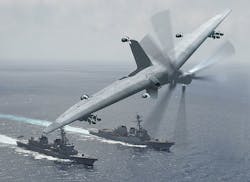Officials of the U.S. Defense Advanced Research Projects Agency (DARPA) in Arlington, Va., announced $17.8 million contract modification Friday to the Northrop Grumman Aerospace Systems segment in Redondo Beach, Calif., for phase-3 work on the Tactically Exploited Reconnaissance Node (TERN) program.
The DARPA TERN program seeks to overcome limitations of Navy shipboard aircraft surveillance. Helicopters are relatively limited in their maximum distances and flight times, for example, while fixed-wing manned and unmanned aircraft must operate from aircraft carriers or large land bases with long runways, although they can fly farther and longer than helicopters.
Northrop Grumman won a $93.1 million contract last December for the third phase of the DARPA TERN program. The program's third phase centers on developing a UAV prototype by November 2017 able to operate from small forward-deployed ships. Northrop Grumman's TERN UAV is expected to combine vertical takeoff and landing with the ability to fly long distances like fix-winged UAVs.
Friday's contract modification asks the company to build and test a second TERN prototype demonstrator unmanned aircraft. Thus far DARPA has spent $150.2 million on the TERN program, DARPA officials say.
Related: DARPA TERN program seeks to operate long-endurance UAVs from fleets of small ships
The TERN program began in March 2013, and in addition to Northrop Grumman has involved four other contractors: AeroVironment Inc. in Monrovia, Calif.; Aurora Flight Sciences Corp. in Manassas, Va.; Carter Aviation Technologies LLC in Wichita Falls, Texas; and Maritime Applied Physics Corp. (MAPC) in Baltimore.
These five contractors won TERN phase-one contracts in fall 2013. Northrop Grumman and AeroVironment won TERN phase-2 contracts in September 2014. DARPA is sponsoring the TERN program together with the U.S. Office of Naval Research (ONR) in Arlington, Va.
The program's first and second phases studied designs for an operational TERN UAV, and began planning for a prototype flight demonstration. In Phase 3 Northrop Grumman is building a full-scale demonstrator TERN system for ground-based testing, culminating in an at-sea demonstration of launch and recovery.
The TERN program seeks to combine the strengths of aircraft bases on land and sea, by using small ships as mobile launch and recovery sites for medium-altitude long-endurance (MALE) fixed-wing UAVs, DARPA officials say.
The ultimate goal for a TERN UAV and launch system to enable persistent intelligence, surveillance, and reconnaissance (ISR) and strike capabilities with payloads as large as 600 pounds while operating at ranges as long as 900 nautical miles from a host vessel.
The TERN system should be able to operate from several relatively small ship types in rough seas, including the 2,784-ton Independence-class littoral combat ship (LCS), which is 418 feet long and 104 feet wide, with a large aft-located flight deck. Other ships of interest are amphibious transport docks, dock landing ships, and Military Sealift Command cargo ships.
The program will produce a low-cost TERN prototype UAV to demonstrate launch, recovery, and enabling technologies. Program thrusts include launch and recovery techniques; aircraft navigation; ship motion prediction; high lift devices; high stroke recovery or arrestment devices; and compact stowage arrangements. Other technologies of interest include automated maintenance systems; robotic deck handling; and automated vehicle preflight checkout.
TERN envisions UAV systems for deep overland ISR and strike missions without forward basing or host nation help. Long radius of action enables access to remote geographic areas while long endurance enables persistent ISR and striking fleeting targets.
A relatively small ship deploying with two or more UAVs could offer high-tempo ISR and strike operations on an as-needed basis, DARPA officials say. The program does not involve helicopters or airships.
Named after the family of sea birds known for flight endurance, TERN aims to make it much easier, quicker and less expensive for the U.S. military to deploy ISR and strike aircraft almost anywhere in the world, DARPA officials say.
The TERN UAV and automated launch-and-recovery system will be able to fly a 600-pound payload as far as 600 to 900 nautical miles from its host vessel.
The TERN program envisions a capability "like having a falcon return to the arm of any person equipped to receive it, instead of to the same static perch every time,” says Daniel Patt, the DARPA TERN program manager.
"About 98 percent of the world’s land area lies within 900 nautical miles of ocean coastlines," Patt explains. "Enabling small ships to launch and retrieve long-endurance UAVs on demand would greatly expand our situational awareness and our ability to quickly and flexibly engage in hot spots over land or water.”
On this contract modification Northrop Grumman will do the work in El Segundo and Mojave, Calif.; East Aurora, N.Y.; and Benbrook, Texas, and should be finished by December 2018.
For more information contact Northrop Grumman Aerospace Systems online at www.northropgrumman.com, the Office of Naval Research at www.onr.navy.mil, or DARPA at www.darpa.mil.



